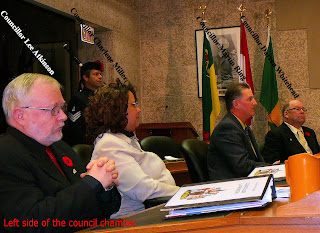The following is a verbatim transcript of Brian Clavier’s presentation to the budget “public consultation” meeting of city council on March 24, 2010. It’s instructive to compare these comments with the March 27 and March 31, 2009 posts, titled “Budget Consultation Presentation” and “Public Budget Consultation Meeting,” respectively. Click on the photo below to enlarge his speaking notes.
-------------------------------------------
I hope, uh, people have had a chance to take a look at the notes that I submitted yesterday afternoon. As you might expect, I do not have enough time to mention everything on those notes, but I will try and hit the high points.
This is the ninth time that I have made a presentation or attended a budget consultation meeting, and I think only Councillor Atkinson and the City Clerk have attended that many. And I find that I’ve had to repeat myself on many of those occasions, and so I’m going to do that today, for the people who haven’t been to as many budget consultation meetings as I have.
I’ve never asked the city to adjust its budget to benefit a specific organization. I’ve never asked the city to adjust its budget to benefit myself personally. I have asked the city to adjust its budget to benefit everyone in the city of Prince Albert - in fact, visitors as well - and that specific request (this is the sixth time I’m making it) is to paint the crosswalks at the intersections that have traffic signals. Four years ago I did a cost estimate, and it was around fifty-one hundred dollars then. It’s probably up to about six thousand dollars now. When I ask you to spend that amount of money painting the crosswalks, I’m asking because it’s a safety issue for everyone involved.
The traffic markings on most of our busy streets get painted twice a year. The traffic light intersection crosswalks have not been painted since 2007 [sic- 2006], and in fact those were done on Central Avenue, 1st Avenue West, 1st Avenue East that year, and they were done about twelve hours before it rained. So the markings didn’t last very long. The paint wasn’t very durable.
When I ask you to do it again - and I would not ask you to do that if I didn’t think that you could find the money somewhere else - and every time I’ve spoken I’ve always found savings in two particular locations. You’ll see those later on, under the category that I’ve described as “Disturbing,” and it’s disturbing because it’s always these two: it’s the golf course and it’s the police department, and it’s really difficult this year with respect to the police department because there are absolutely no numbers available to the public. This is the first year that’s happened.
The last time I spoke at this podium about a city budget I was amazed that I had to say that the city’s budget for fuel for its police vehicles was under one hundred dollars - for the entire year 2008. [See the March 27, 2009 verbatim transcript post - which may explain why the 2010 budget documents available to the public do not contain any breakdown of police expenditures: zero information equals zero potential for criticism.]
You’ll notice that I have a reference here to the fact that the Police Board decides the budget: city council does not get to make any changes to the allocations therein. On the other hand, city council does have the ability to say, “We are-- this budget is unacceptable right now, we are returning it back to you for revision.” You have that ability.
Last year it was the Dragonfly [remote-controlled] helicopter; this year it’s purchases of vehicles that really should be kept on the road a lot longer. It’s already been mentioned in previous discussions of the police budget at council meetings that surely, these police vehicles should be lasting longer than they do.
The other place - the golf course - and I’m going to specifically refer to “wetting agent, fungicide, and fertilizer,” four thousand, nine hundred and fifty dollars. If we have to have a golf course, then surely we shouldn’t be using chemicals on it to make it look pretty. There are golf courses in the world that are actually “green” - they don’t use water, they don’t use chemicals. I think that’s something that needs serious consideration.
The other thing I want to remind people about is the 3.5% cap that administration asked the departments and external agencies to adhere to. And it’s really important to note that only two have actually met that. The library - JMC - is 5% under last year’s request, and Wapiti [Regional Library] is 2.8% over. Everybody else - the previous speaker, for ins-- for-- for example: their organization is asking for . . . an increase of 31% compared to 2009. PADIDA [Prince Albert Downtown Improvement District Association] - and I think the councillor for ward four should actually excuse herself from this discussion [her day job is Executive Director of PADIDA. . . .] - is asking for 24% more this year. Even the Community Service Centre, for its two budgets, seniors’ transportation and special needs transportation, is asking for four-and-a-half and 3.6% increases. Apparently the request for holding the line at 3.5% gets ignored by everybody except the two institutions that have the most highly-educated staff.
The police are asking for 7.6% more, and ultimately the taxpayer’s being asked - the last number that I recall seeing when I went through the over-five-hundred pages of documents - was 6.6% from the taxpayer.
If you have any questions, I’d be pleased to answer, because my time is up.









